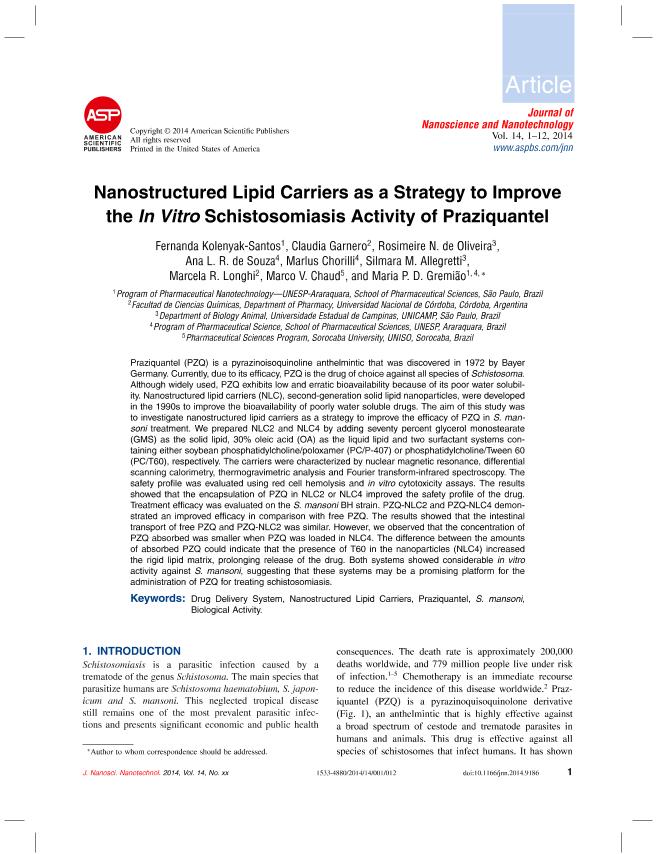Artículo
Nanostructured lipid carriers as a strategy to improve the in vitro schistosomiasis activity of Praziquantel
Kolenyak Santos, Fernanda; Garnero, Claudia ; De Oliveira, Rosimeire N.; De Souza, Ana L. R.; Chorilli, Marlus; Allegretti, Silmara M.; Longhi, Marcela Raquel
; De Oliveira, Rosimeire N.; De Souza, Ana L. R.; Chorilli, Marlus; Allegretti, Silmara M.; Longhi, Marcela Raquel ; Chaud, Marco V.; Gremião, Maria P.D.
; Chaud, Marco V.; Gremião, Maria P.D.
 ; De Oliveira, Rosimeire N.; De Souza, Ana L. R.; Chorilli, Marlus; Allegretti, Silmara M.; Longhi, Marcela Raquel
; De Oliveira, Rosimeire N.; De Souza, Ana L. R.; Chorilli, Marlus; Allegretti, Silmara M.; Longhi, Marcela Raquel ; Chaud, Marco V.; Gremião, Maria P.D.
; Chaud, Marco V.; Gremião, Maria P.D.
Fecha de publicación:
01/2015
Editorial:
American Scientific Publishers
Revista:
Journal of Nanoscience and Nanotechnology
ISSN:
1533-4880
Idioma:
Inglés
Tipo de recurso:
Artículo publicado
Clasificación temática:
Resumen
Praziquantel (PZQ) is a pyrazinoisoquinoline anthelmintic that was discovered in 1972 by Bayer Germany. Currently, due to its efficacy, PZQ is the drug of choice against all species of Schistosoma. Although widely used, PZQ exhibits low and erratic bioavailability because of its poor water solubility. Nanostructured lipid carriers (NLC), second-generation solid lipid nanoparticles, were developed in the 1990s to improve the bioavailability of poorly water soluble drugs. The aim of this study was to investigate nanostructured lipid carriers as a strategy to improve the efficacy of PZQ in S. mansoni treatment. We prepared NLC2 and NLC4 by adding seventy percent glycerol monostearate (GMS) as the solid lipid, 30% oleic acid (OA) as the liquid lipid and two surfactant systems containing either soybean phosphatidylcholine/poloxamer (PC/P-407) or phosphatidylcholine/Tween 60 (PC/T60), respectively. The carriers were characterized by nuclear magnetic resonance, differential scanning calorimetry, thermogravimetric analysis and Fourier transform-infrared spectroscopy. The safety profile was evaluated using red cell hemolysis and in vitro cytotoxicity assays. The results showed that the encapsulation of PZQ in NLC2 or NLC4 improved the safety profile of the drug. Treatment efficacy was evaluated on the S. mansoni BH strain. PZQ-NLC2 and PZQ-NLC4 demonstrated an improved efficacy in comparison with free PZQ. The results showed that the intestinal transport of free PZQ and PZQ-NLC2 was similar. However, we observed that the concentration of PZQ absorbed was smaller when PZQ was loaded in NLC4. The difference between the amounts of absorbed PZQ could indicate that the presence of T60 in the nanoparticles (NLC4) increased the rigid lipid matrix, prolonging release of the drug. Both systems showed considerable in vitro activity against S. mansoni, suggesting that these systems may be a promising platform for the administration of PZQ for treating schistosomiasis.
Archivos asociados
Licencia
Identificadores
Colecciones
Articulos(UNITEFA)
Articulos de UNIDAD DE INVESTIGACION Y DESARROLLO EN TECNOLOGIA FARMACEUTICA
Articulos de UNIDAD DE INVESTIGACION Y DESARROLLO EN TECNOLOGIA FARMACEUTICA
Citación
Kolenyak Santos, Fernanda; Garnero, Claudia; De Oliveira, Rosimeire N.; De Souza, Ana L. R.; Chorilli, Marlus; et al.; Nanostructured lipid carriers as a strategy to improve the in vitro schistosomiasis activity of Praziquantel; American Scientific Publishers; Journal of Nanoscience and Nanotechnology; 15; 1; 1-2015; 761-772
Compartir
Altmétricas



